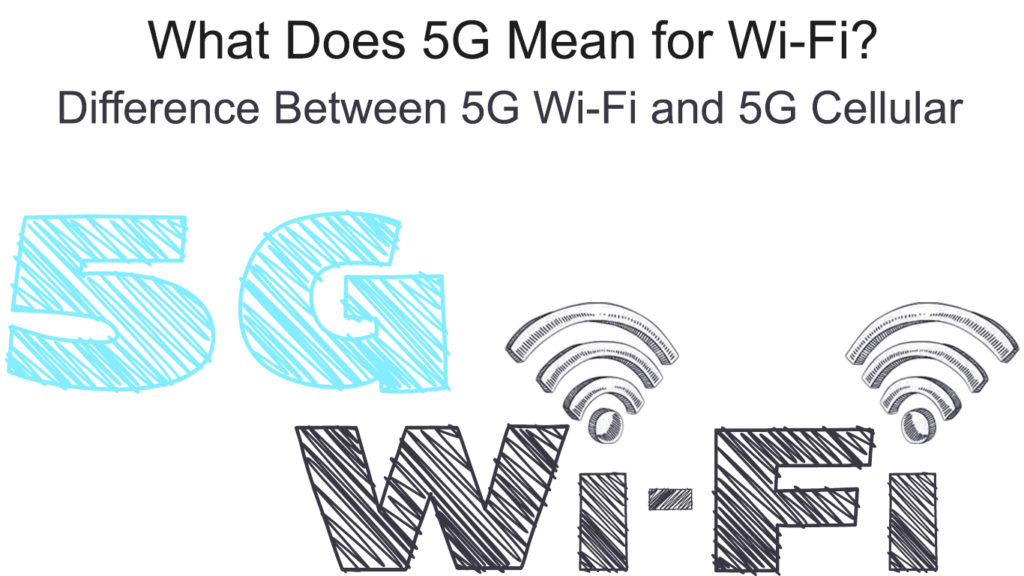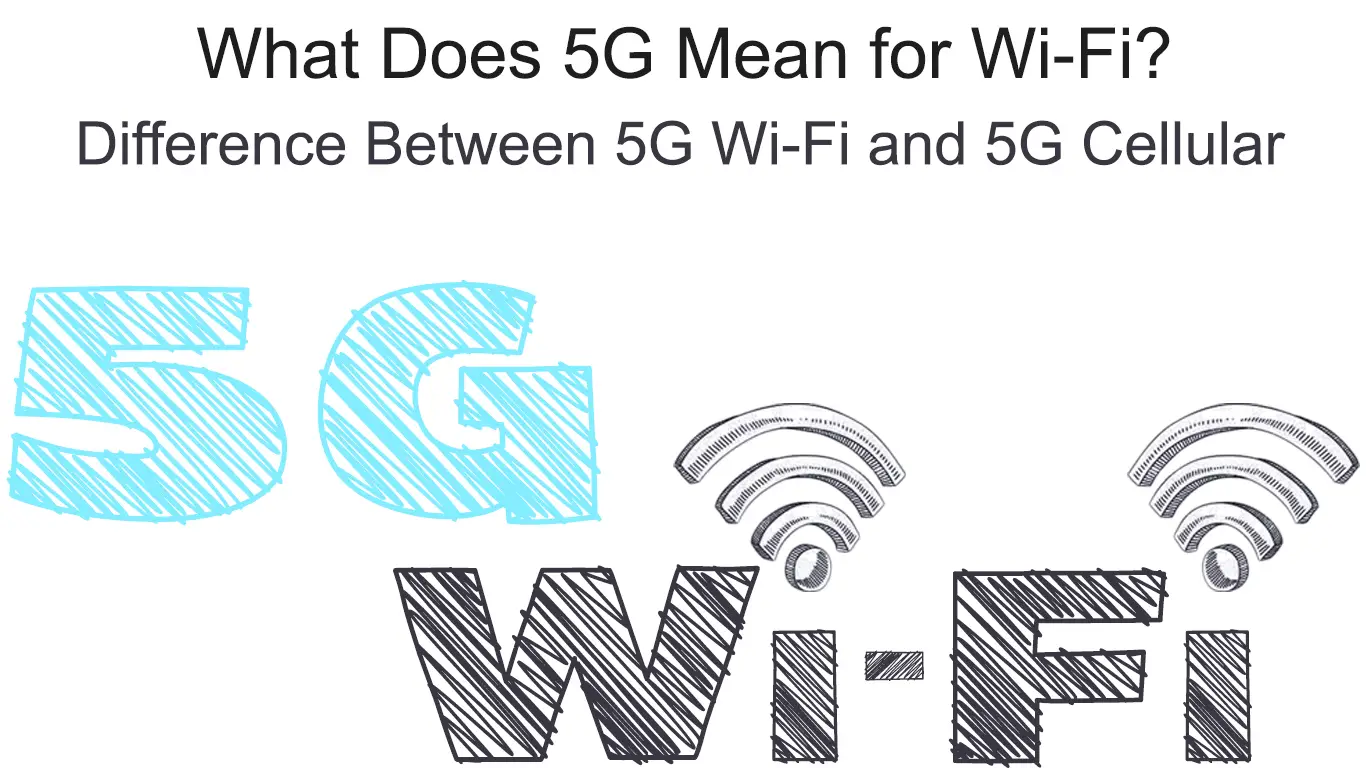The future of mobile networks and internet connectivity seems bright as we enter the 5G era. Today, it is supposedly the fastest, most robust, and most reliable wireless technology.
5G promises to deliver higher bandwidth, lower latency, breakneck data speeds, and transformative connectivity options, giving your Wi-Fi connection stiff competition.
Industry experts project that 5G will cover 40 percent of the world by 2024 as more 5G-compatible devices hit the market.
So, what does 5G mean for Wi-Fi and other wireless technologies?
This post explains everything you need to know about 5G and its possible impact on Wi-Fi technology.
So, let’s get straight to it.

CONTENTS
What is 5G?
5G is an acronym for the fifth generation of broadband cellular networks, and it is the latest global wireless mobile standard after 4G.
This wireless standard is renowned for its multi-gigabit speeds, with estimated peak rates expected to reach 20 Gbps. 5G can send and receive signals instantaneously, providing 100 times more speed than its predecessor.
It offers ultra-low latency of 1 millisecond, allowing for faster connections and higher bandwidth for greater network capacity.
Its primary application area is the Enhanced Mobile Broadband (eMBB), advancing from its predecessor, 4G LTE mobile broadband.
Other 5G application areas such as Ultra-Reliable Low Latency Communications and Massive Machine Type Communications are years away from implementation.
Introduction to 5G
Brief History of 5G
The 5G cellular network standard is a brainchild of NASA and was first conceptualized in 2008. However, it wasn’t until 2019 that the deployment of 5G became a reality, with South Korea the first country to offer this wireless standard.
Big telco companies such as LG Uplus, KT, and SK Telecom began rolling out the 5G standard in South Korea, with over 40,000 users joining the network on its launch day.
Verizon rolled out 5G in the United States a few hours later, turning the deployment of the network into a supremacy battle between the US and South Korea.
As more countries continue to supplant 4G in favor of 5G, experts project over 60 percent subscription by the end of 2025.
How Does 5G Work?
5G uses Orthogonal Frequency-Division Multiplexing (OFDM) to modulate digital signals across several channels, minimizing interference and improving traffic capacity and overall network efficiency.
Unlike other wireless networks that use high-power cell towers to transmit signals over long distances, 5G operates using multiple small cell stations located on roofs and light poles to radiate signals.
Since 5G relies on the millimeter-wave (mmWave) spectrum to generate high speeds, the network signals can only travel short distances, explaining why multiple small cell stations are vital in signal transmission using 5G.
How Does 5G Work?
Differences Between 5G and Wi-Fi
5G and Wi-Fi might seem similar since they are both wireless networking standards. However, they differ slightly.
Here are the most notable differences between 5G and Wi-Fi:
- Technology
While 5G is a wireless standard primarily for mobile networks, Wi-Fi focuses on internet connectivity rather than mobile networks.
5G connects multiple wireless devices using cellular networks. In contrast, Wi-Fi links multiple compatible devices wirelessly to form a LAN network for internet access.
- Wireless Standard
5G operates based on the 3rd Generation Partnership Project (3GPP) specifications, while Wi-Fi works based on the Institute of Electrical and Electronics Engineers (IEEE) 802.11 standard.
- Spectrum
Wireless networks such as 5G and Wi-Fi transmit signals over various radio wave spectrum bands.
Since 5G is a cellular network standard, it has to rely on licensed spectrum bands in line with government regulations. Cellular carriers pay to use these bands and recoup their money by charging subscribers.
In contrast, Wi-Fi technology is open and unregulated, meaning it uses unlicensed spectrum bands to transmit signals to compatible devices certified by the FCC.
- Range
As much as 5G is renowned for its high speeds and network efficiency, it has a shorter range than Wi-Fi networks for internet connections but a longer range for mobile connections.
5G operates using multiple small cell stations and relies on the millimeter-wave spectrum to transmit signals. These cells support a range between 10-100 meters.
Wi-Fi supports a range greater than 100 meters, with beamforming technology improving transmission distances exceptionally.
- Frequency Bands
Wi-Fi technology uses two primary frequency bands, including 2.4 GHz and 5 GHz. These bands have varying properties as far as speed and range are concerned.
5G operates using multiple frequencies. However, 28 GHz and 39 GHz are the most commonly used. These mmWave bands support high-speed data transmission over short distances and aid in improving network speed and capacity.
- Deployment Cost
Deployment cost is another significant difference between 5G and Wi-Fi networks. Since 5G is still in its nascent implementation stages, the deployment costs are relatively higher than Wi-Fi technology.
- Mobility and Application
5G has greater mobility than Wi-Fi technology, and most of its application areas are outdoors. In contrast, Wi-Fi has limited mobility compared to 5G, and most Wi-Fi applications are indoors.
Wi-Fi 6 VS 5G – In-Depth Comparison
Is 5G and 5 GHz in Wi-Fi the Same?
5G and 5 GHz Wi-Fi are not the same. While 5G refers to the fifth generation of broadband cellular networks, 5 GHz is a frequency band Wi-Fi routers use to transmit Wi-Fi signals to compatible devices.
5G is a wireless telecommunication standard exclusive to cellular networks. In contrast, 5 GHz is the frequency band that carries data signals at high speeds between the router or access point to connected devices.
The only similarity between 5G and 5 GHz is that they broadcast signals at breakneck speeds and are both used for wireless connectivity.
Will 5G Replace Wi-Fi?
5G cannot replace Wi-Fi. After all, they are two different wireless standards with nothing much in common. While 5G is for cellular networks, Wi-Fi is for WLAN networks.
Besides, deploying and maintaining Wi-Fi technology is far much cheaper. For this reason, Wi-Fi will always remain the predominant standard for residential and commercial environments.
Recommended reading:
- What Is a Group Key Rotation Interval? (WPA Group Key Rotation Explained)
- Wi-Fi Pineapple Explained (What Is It and Do You Need It?)
- Your Broadband Modem is Experiencing Connectivity Issues (Proven Fixes)
Here are some of the top reasons why 5G won’t replace Wi-Fi anytime soon:
- Network Functionality
5G and Wi-Fi function differently and the technologies differ in how they handle networking issues. Besides, most Wi-Fi-specific functionalities are not compatible with 5G cellular networks.
Wi-Fi is also open and unregulated while 5G operates on a licensed and regulated spectrum. These differences mean that specific devices can only operate on either a Wi-Fi or 5G infrastructure.
- Security Concerns
Even though 5G is one of the latest wireless standards, it has a few security concerns that could open ground for a new era of digital threats.
5G does not allow for personalized control and security deployment. In contrast, you can make your Wi-Fi network private, reducing the chances of cyberattacks.
The reduced security concerns make Wi-Fi wireless networks the preferred choice for many home and business environments.
5G Security Concerns
- Electromagnetic Interference
5G has faster speeds and low latency but is still prone to electromagnetic interference caused by objects such as weather satellites. Physical objects can also diffuse and reduce the propagation of 5G signals.
Even though Wi-Fi is not immune to electromagnetic interference, using the 5 GHz band can help tackle this issue.
Can 5G and Wi-Fi Work Together?
5G and Wi-Fi can work together using various networking functions to reduce operational costs, energy consumption, and complexity.
They both can achieve Gigabit speeds and reduce latency, guaranteeing end-users an exceptional experience.
Pros of 5G
- Higher Bandwidth: 5G has higher bandwidth, allowing for multiple connections without congesting the network. The increased bandwidth results in higher data rates facilitated by massive MIMO technology and carrier aggregation.
- Low Latency: One of the most notable improvements associated with the 5G network is low latency. It offers ultra-low latency of 1 millisecond, allowing for faster, uninterrupted connections.
- High-Speed Connectivity: 5G is renowned for its multi-gigabit speeds, reaching up to 20 Gbps. It can send and receive signals instantaneously, providing 100 times more speed than any other network.
- Improved Network Efficiency: 5G has ten times more data throughput, three times improvement in spectrum efficiency, and a hundred times better traffic capacity for improved overall network performance.
Cons of 5G
- Limited Global Coverage: The 5G network is not available everywhere but plans are underway to increase coverage within the next few years.
- Signal Degradation: 5G is prone to signal degradation since it can only transmit data at high speeds but over shorter distances. Since 5G uses higher frequencies, it cannot penetrate physical objects.
- Deployment Costs: 5G has higher deployment and maintenance costs than Wi-Fi technology. Besides, it requires highly skilled engineers and personnel to install and maintain the network.
Take Away
The emergence of the 5G cellular standard has opened up numerous opportunities in technology.
It uses technological elements such as Massive MIMO, beamforming, and edge computing to enhance data transmission speeds, improve network efficiency, and reduce latency.
The best part about 5G is that it is not here to replace Wi-Fi but rather to complement it. 5G and Wi-Fi can work together to transform industries, advance societies, and elevate user experiences.

Hey, I’m Jeremy Clifford. I hold a bachelor’s degree in information systems, and I’m a certified network specialist. I worked for several internet providers in LA, San Francisco, Sacramento, and Seattle over the past 21 years.
I worked as a customer service operator, field technician, network engineer, and network specialist. During my career in networking, I’ve come across numerous modems, gateways, routers, and other networking hardware. I’ve installed network equipment, fixed it, designed and administrated networks, etc.
Networking is my passion, and I’m eager to share everything I know with you. On this website, you can read my modem and router reviews, as well as various how-to guides designed to help you solve your network problems. I want to liberate you from the fear that most users feel when they have to deal with modem and router settings.
My favorite free-time activities are gaming, movie-watching, and cooking. I also enjoy fishing, although I’m not good at it. What I’m good at is annoying David when we are fishing together. Apparently, you’re not supposed to talk or laugh while fishing – it scares the fishes.

